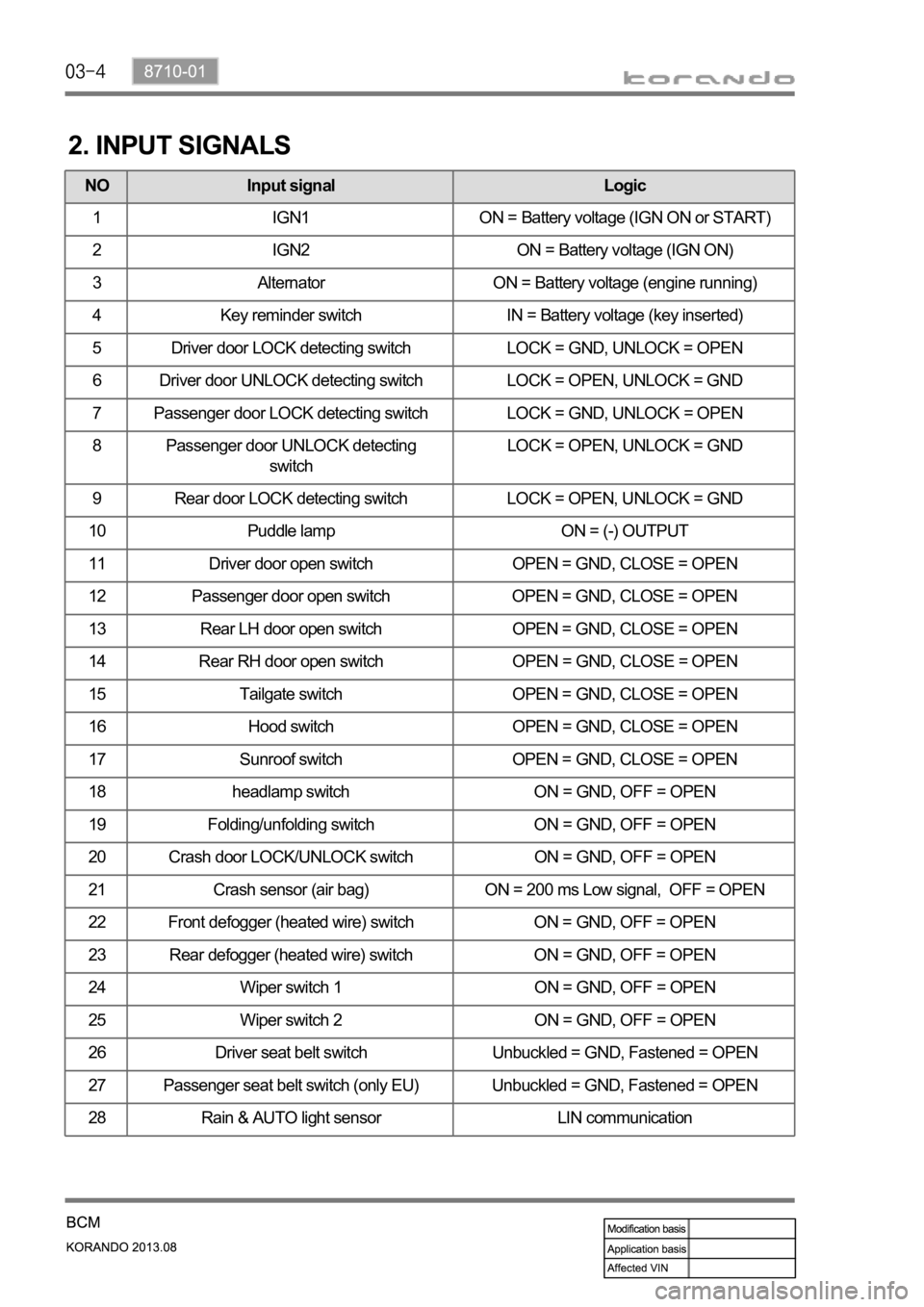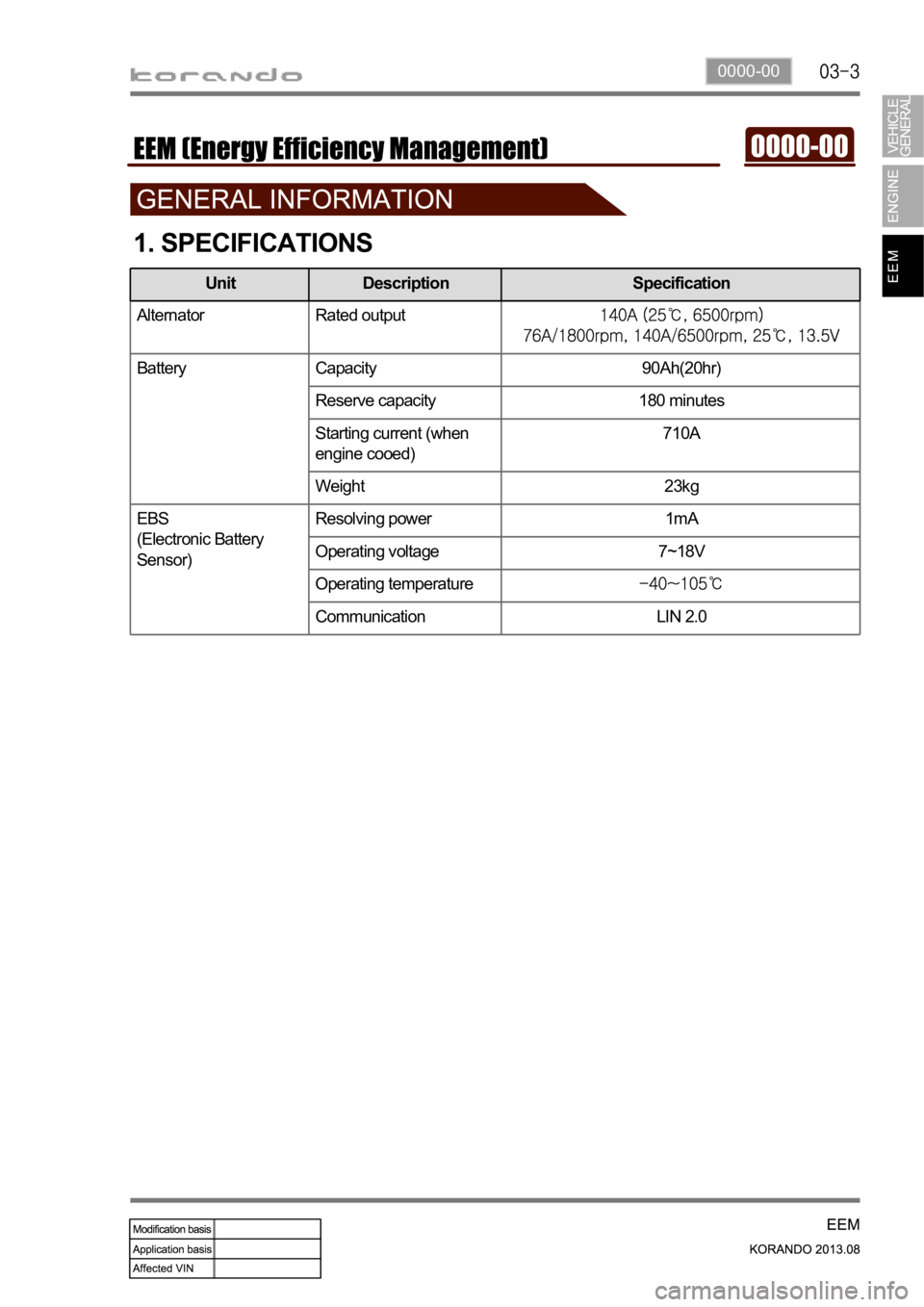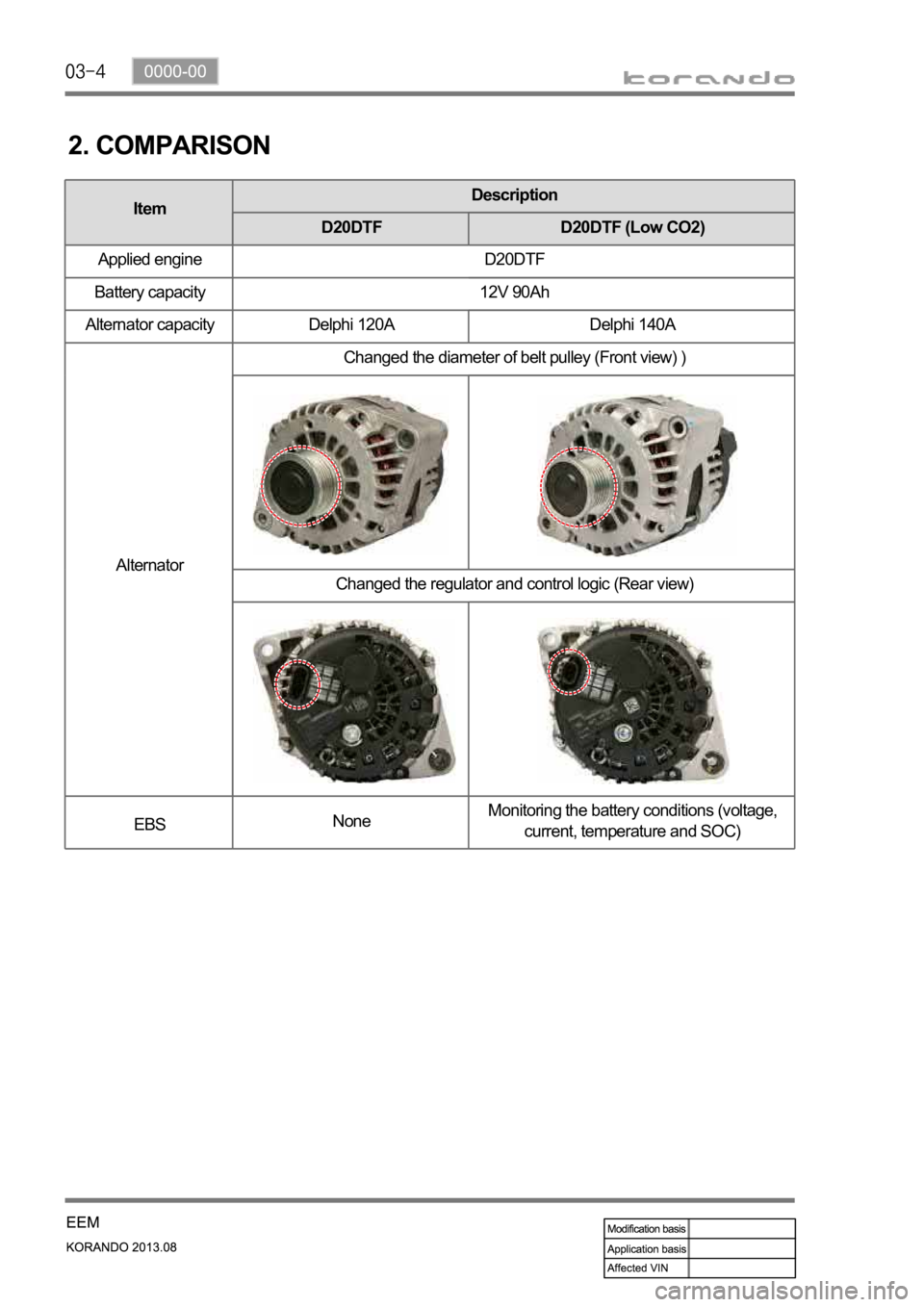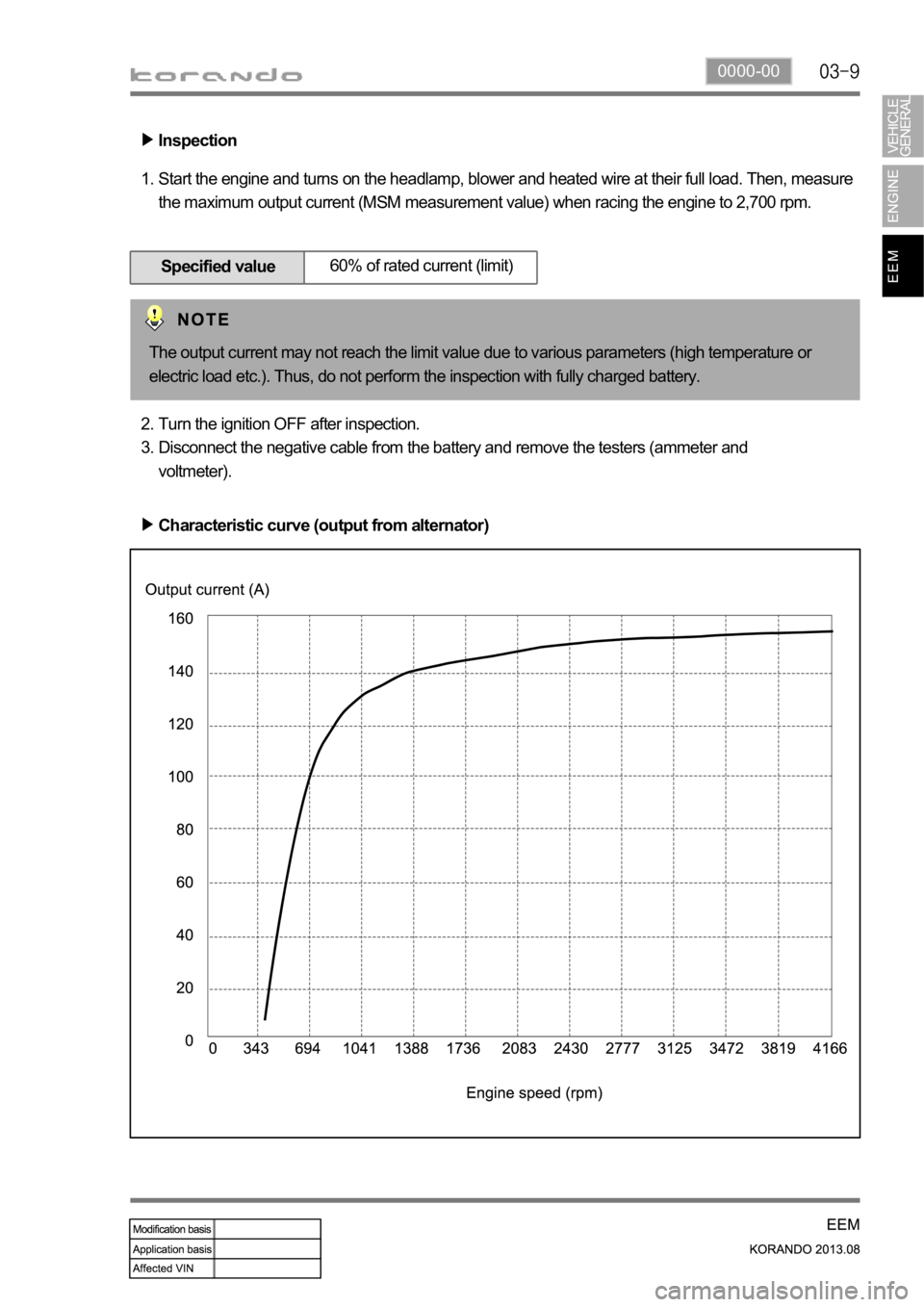SSANGYONG KORANDO 2013 Owner's Manual
KORANDO 2013
SSANGYONG
SSANGYONG
https://www.carmanualsonline.info/img/67/57503/w960_57503-0.png
SSANGYONG KORANDO 2013 Owner's Manual
Page 597 of 1336
0000-00
1. SPECIFICATIONS
Alternator Rated output
Battery Capacity 90Ah(20hr)
Reserve capacity 180 minutes
Starting current (when
engine cooed)710A
Weight 23kg
EBS
(Electronic Battery
Sensor)Resolving power 1mA
Operating voltage 7~18V
Operating temperature
Communication LIN 2.0
Unit Description Specification
Page 598 of 1336
ItemDescription
D20DTF D20DTF (Low CO2)
Applied engine D20DTF
Battery capacity 12V 90Ah
Alternator capacity Delphi 120A Delphi 140A
AlternatorChanged the diameter of belt pulley (Front view) )
Changed the regulator and control logic (Rear view)
EBSNoneMonitoring the battery conditions (voltage,
current, temperature and SOC)
2. COMPARISON
Page 601 of 1336
0000-00
Measuring the voltage drop between lines
Measure the voltage drop between alternator B+ and battery B+. -
Specified valuebelow 0.3V
If the value is out of the specified value, check the terminal and clamp for looseness.
Checking the charge warning lamp
Check if the charge warning lamp goes out.
If the charge warning lamp does not go off, inspect the electric circuit.
Start the engine and check if the charge warning lamp keeps off. 1.
2.
-
3.
Page 603 of 1336
0000-00
Inspection
Start the engine and turns on the headlamp, blower and heated wire at their full load. Then, measure
the maximum output current (MSM measurement value) when racing the engine to 2,700 rpm. 1.
Specified value60% of rated current (limit)
Turn the ignition OFF after inspection.
Disconnect the negative cable from the battery and remove the testers (ammeter and
voltmeter). 2.
3.
Characteristic curve (output from alternator)
The output current may not reach the limit value due to various parameters (high temperature or
electric load etc.). Thus, do not perform the inspection with fully charged battery.
Page 604 of 1336
5. INSPECTION - REGULATING VOLTAGE
Perform the basic inspection. -
Setting up the testers
Preparation
Set up the ammeter and voltmeter as shown
in the figure. 1.
Inspection
Turn the ignition ON and measure the voltage on the voltmeter. 1.
Start the engine and turn all electric devices OFF.
Increase the engine speed to 2,700 rpm and maintain the speed. Measure the voltage when the
output current from alternator decrease below 30A. 2.
3.
Specified valueover 12V
Specified value11.5 ~ 15.5V
Make sure to set up the tester while keeping
its polarity.
Page 609 of 1336
0000-00
8. DTC SETTING CONDITIONS
Charge warning lamp ON condition
Turn the ignition ON (Engine stopped)
Open or short circuit of L terminal wiring, open or short internal circuit of alternator (fixed control of
13.8V)
Open or short circuit of F terminal wiring, no feedback output signal 1.
2.
3.
Page 610 of 1336
1. LAYOUT
D20DTF(Low CO2) D20DTF
ECUBattery sensor (EBS)
Alternator (ALT)
Meter cluster (charge
warning lamp)
Page 612 of 1336
Operation of charge warning lamp
ECU checks the generating voltage from alternator and circuit conditions and sends the warning lamp ON
signal to meter cluster through CAN line.Basic control logic according to the driving conditions
Engine ECU determines the engine loads according to the fuel injection volume and engine speed. It
charges the battery by increasing the generating voltage during deceleration. To improve the fuel
economy by reducing the alternator load during acceleration, engine ECU decreases the generating
voltage and consumes the battery voltage.
Page 613 of 1336
0000-00
3. CAN COMMUNICATION (Charge Warning Lamp)
Overview
Meter cluster
(charge warning lamp)
The meter cluster receives the charge warning lamp ON signal from ECU through CAN line.
Charge warning lamp ON conditions
Pre-warning
When DTC related EEM set
Open or short circuit in alternator -
-
-
Circuit diagram
Page 636 of 1336

2. INPUT SIGNALS
NO Input signal Logic
1 IGN1 ON = Battery voltage (IGN ON or START)
2 IGN2 ON = Battery voltage (IGN ON)
3 Alternator ON = Battery voltage (engine running)
4 Key reminder switch IN = Battery voltage (key inserted)
5 Driver door LOCK detecting switch LOCK = GND, UNLOCK = OPEN
6 Driver door UNLOCK detecting switch LOCK = OPEN, UNLOCK = GND
7 Passenger door LOCK detecting switch LOCK = GND, UNLOCK = OPEN
8 Passenger door UNLOCK detecting
switchLOCK = OPEN, UNLOCK = GND
9 Rear door LOCK detecting switch LOCK = OPEN, UNLOCK = GND
10 Puddle lamp ON = (-) OUTPUT
11 Driver door open switch OPEN = GND, CLOSE = OPEN
12 Passenger door open switch OPEN = GND, CLOSE = OPEN
13 Rear LH door open switch OPEN = GND, CLOSE = OPEN
14 Rear RH door open switch OPEN = GND, CLOSE = OPEN
15 Tailgate switch OPEN = GND, CLOSE = OPEN
16 Hood switch OPEN = GND, CLOSE = OPEN
17 Sunroof switch OPEN = GND, CLOSE = OPEN
18 headlamp switch ON = GND, OFF = OPEN
19 Folding/unfolding switch ON = GND, OFF = OPEN
20 Crash door LOCK/UNLOCK switch ON = GND, OFF = OPEN
21 Crash sensor (air bag) ON = 200 ms Low signal, OFF = OPEN
22 Front defogger (heated wire) switch ON = GND, OFF = OPEN
23 Rear defogger (heated wire) switch ON = GND, OFF = OPEN
24 Wiper switch 1 ON = GND, OFF = OPEN
25 Wiper switch 2 ON = GND, OFF = OPEN
26 Driver seat belt switch Unbuckled = GND, Fastened = OPEN
27 Passenger seat belt switch (only EU) Unbuckled = GND, Fastened = OPEN
28 Rain & AUTO light sensor LIN communication









